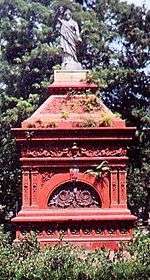World Cotton Centennial


The 1884 World's Fair was held in New Orleans, Louisiana. At a time when nearly one-third of all cotton produced in the United States was handled in New Orleans and the city was home to the Cotton Exchange, the idea for the fair was first advanced by the Cotton Planters Association. The name World Cotton Centennial referred to the earliest-surviving record of export of a shipment of cotton from the U.S. to England in 1784. It was also known as the World's Industrial and Cotton Centennial Exposition.
The U.S. Congress lent $1 million to the Fair's directors and gave $300,000 for the construction of a large US Government & State Exhibits Hall on the site.[1] However, the planning and construction of the fair was marked by corruption and scandals, and state treasurer Edward A. Burke absconded abroad with some $ 1,777,000 dollars of state money including most of the fair's budget.[2]
Despite such serious financial difficulties, the Fair succeeded in offering many attractions to visitors. It covered 249 acres (101 ha), stretching from St. Charles Avenue to the Mississippi River, and was notable in that it could be entered directly by railway, steamboat, or ocean-going ship. The main building enclosed 33 acres (13 ha) and was the largest roofed structure constructed up to that time. It was illuminated with 5,000 electric lights (still a novelty at the time, and said to be 10 times the number then existing in New Orleans outside of the fairgrounds). There was also a Horticultural Hall, an observation tower with electric elevators, and working examples of multiple designs of experimental electric street-cars. The Mexican exhibit was particularly lavish and popular, constructed at a cost of $200,000 dollars, and featuring a huge brass band that was a great hit locally.
On December 16, 1884, U.S. President Chester Arthur opened the Fair via telegraph (two weeks behind schedule).[1] It closed on June 2, 1885. In an unsuccessful attempt to recover some of the financial losses from the Fair, the grounds and structures were reused for the North Central & South American Exposition from November 10, 1885, to March 31, 1886, with little success. After this the structures were publicly auctioned off, most going only for their worth in scrap.
The site today is Audubon Park and Audubon Zoo in uptown New Orleans.
See also
- International Cotton Exposition, 1881 in Atlanta
- Cotton States and International Exposition, 1895 in Atlanta
- 1984 Louisiana World Exposition, in New Orleans, 100 years after the World Cotton Centennial
References
Further reading
- Practical common sense guide book through the World's Industrial and Cotton Centennial Exposition at New Orleans .. Harrisburg, Pa: L. S. Hart, printer. 1885.
External links
| Wikimedia Commons has media related to World Cotton Centennial. |
- The World's Cotton Centennial Exposition (Kendall's History of New Orleans, Chapter 29)
- New Orleans Centennial Exposition Stereoscopic Views, Louisiana Digital Library
| Preceded by Melbourne International Exhibition (1880) |
World Expositions 1884 |
Succeeded by Exposición Universal de Barcelona (1888) |